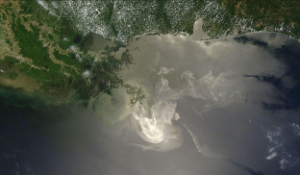On April 20, 2010, the Deepwater Horizon oil rig exploded off the coast of Louisiana. The resulting oil spill lasted 87 days and created the largest accidental release of oil the world had ever seen. While much of the northern Gulf of Mexico was spared, receiving little to no oil, other areas were heavily impacted. Several different methods were used to contain and clean up the oil, with varied success. Efforts to remove oil from the water and beaches are onging where necessary. Scientists continue to monitor coastal habitats to document and understand both the short- and long-term effects.
Classroom Activity: Still the Spill
Protecting the estuaries and coastal habitats of the northern Gulf of Mexico was of utmost importance during the Deepwater Horizon oil spill. A variety of materials were used to protect habitats and clean up the oil as it came ashore. Dispersants, chemicals that break down hydrocarbons, were used in some locations.
An Overview of the Deepwater Horizon Oil Spill – PDF 1.4MB

